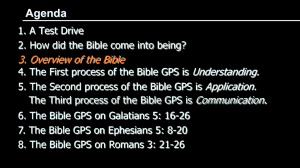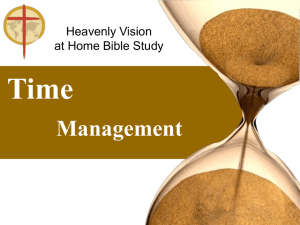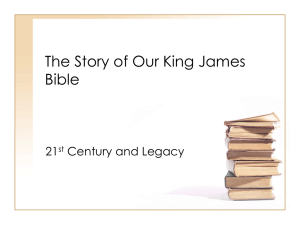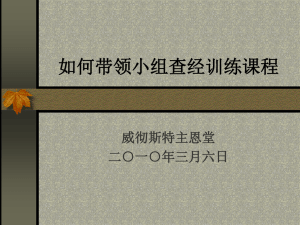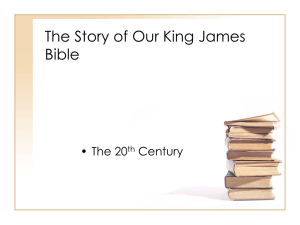Lesson 11 - Berachah Bible Church
advertisement
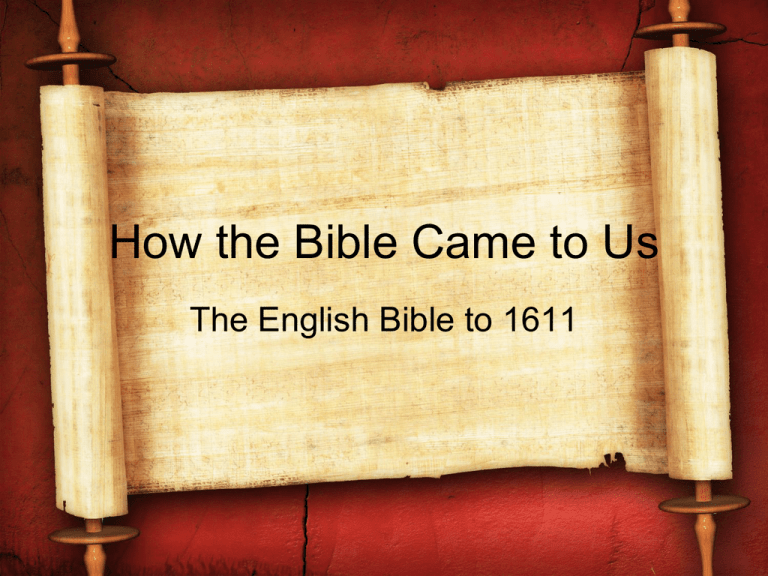
How the Bible Came to Us The English Bible to 1611 Introductory Remarks • For more than nine hundred years (fourth to fourteenth centuries) English-speaking people did not have a Bible in their own language. – A major reason for this was the 1000 year dominance of the Latin Vulgate as the authoritative translation in the church. – Second, few had the skill or the time to render the Bible into English. – Third, the church was reluctant, even antagonistic, towards having the Bible translated into English, fearing it would lose power and revenue. Some Historical Background • The Romans conquered Britain in the early second century. • By this time Christianity was well established in the Roman Empire...as was persecution of Christians. • This persecution caused Christians to flee to the farthest reaches of the Empire. – There is evidence that Christianity had reached England by at least the early fourth century. – Constantine’s decree in 313 was a very significant change in direction, but Latin would remain the language of the church for centuries. Early on, only small portions of Scripture were translated into English from the Latin Vulgate. Some Historical Background • When the French-speaking Normans conquered England in 1066, Old English culture was dealt a death blow. • By the twelfth century the English language had virtually died out. • But in the middle twelfth century, a new language – a mixture of Norman and Old English – came into being and Middle English was born. – Still, for three more centuries, few Bible books were translated into English. The Wycliffe Bible (NT, 1380; Entire Bible, 1382) • John Wycliffe (c. 1329-1384) was a brilliant English scholar, lecturer (at Oxford University), debater, and churchman. • In time he grew concerned about the power and corruption in the established Church, and began to speak and write about this. • Wycliffe was convinced that the people needed the Bible in their own language. – His translation was from the Latin Vulgate. A second edition appeared in 1388. – The hierarchy of the church condemned the Bible. Yet the threat of severe penalties for those found reading it had the reverse effect of arousing interest, in both the Bible and literacy. – A number of Wycliffe’s associates were executed; his bones were dug up and burned, and the ashes scattered in the River Swift. The Tyndale Bible (NT, 1526; OT Portions 1534) • • • • • While opposition to translations into English remained strong, William Tyndale (c. 1494-1536) translated the NT into English in 1526. Tyndale taught at Oxford and Cambridge and became proficient in Greek. Tyndale was initially housed in London by a wealthy English cloth merchant as he began his work, but subsequently fled to Hamburg to finish it. His NT was printed in Worms, Germany, then smuggled into England in cotton bales or other containers. Cuthbert Tunstall, bishop of London and the man from whom Tyndale had sought permission to translate the Bible, sought to buy and destroy every copy he could...which actually helped Tyndale in his work through increased sales! – His revised and corrected edition of 1534 was his best work. • Tyndale was kidnapped from Antwerp and imprisoned near Brussels, Belgium. – In addition to warmer clothing, he requested a copy of the Hebrew Bible and a Hebrew grammar and dictionary, in order to translate the OT. – In 1536 he was found guilty of heresy and executed. Comparison between Wycliffe’s and Tyndale’s Bibles • Wycliffe’s Bible – Translated from the Latin Vulgate – Hand copied – Middle English • Tyndale’s Bible – Translated from Greek and Hebrew. – Printed – Modern English – Included marginal notes, about half of which were translated from Luther’s Bible. The Coverdale Bible (1535) • Miles Coverdale (1488-1569) was an avid learner who, under the influence of the Reformation, left his order as an Augustinian friar. • Coverdale developed his edition while in exile in Antwerp. – Not proficient in the biblical languages, he consulted five earlier translations. • Upon hearing of King Henry VIII’s amenability to an English translation, he dedicated the work to him. – The king subsequently accepted the translation. – Though it was re-printed twice, it never became an authorized English version. • Coverdale also edited the Great Bible (1539), which was a revision of the Matthew Bible and so named because of its size (11 x 16.5). – It was the first English Bible to be authorized for public use in churches. The Matthew Bible (1537) • John Rogers studied at Cambridge, served as a rector in a London church, and helped smuggle Bibles into England. • He took the pen name of Thomas Matthew and finished editing the OT portion of Tyndale’s Bible. • By this time the Bible in English was gaining widespread popularity...but when England reverted to Roman Catholicism under Mary Tudor, Rogers was one of the first people to be burned at the stake in 1555. The Geneva Bible (1560) • During the reign of Mary, Protestant fugitives fled to Geneva, which was a safe haven for biblical scholarship. – William Wittingham, brother-in-law of Calvin’s wife and an instructor at All Souls College at Oxford, was one of these fugitives. • Whittingham undertook a revision of the English Bible which came to be known as the Geneva Bible and which was dedicated to Queen Elizabeth I, who favored Protestantism. • This was a thorough revision of the Great Bible in the OT. The NT was primarily Tyndale’s version, with some revisions based on the Great Bible and Beza’s Latin NT. – The marginal notes were clearly Calvinistic and anti-Roman, and made a strong impact upon the people of England and Scotland...but this Bible was never authorized to be read in the churches of England. The Bishops’ Bible (1568) • Recognizing the need for a new translation, Matthew Parker, Archbishop of Canterbury, was asked to oversee a revision of the Great Bible. – Bishops were also invited to participate, hence the name. • This became the authorized version and was placed in all the churches. – Its few footnotes were expressly noncontroversial. The Douay-Rheims Bible (NT, 1582; OT, 1609-10) • Driven by Protestant translations with the notes of Calvin and other Protestants, Roman Catholics needed an English translation with notes supporting its doctrine. • William Allen, an Oxford fellow and devout Roman Catholic, along with Gregory Martin, a lecturer at St. John’s College, worked together to fill this need. • This Bible sought to refute the “false teachings” of Protestantism, particularly in the marginal notes. • It was based on the Latin Vulgate and not as good a translation as the Protestant versions, but served its purpose of getting the Bible into English for Roman Catholics. Next Time: The Authorized Version of 1611

